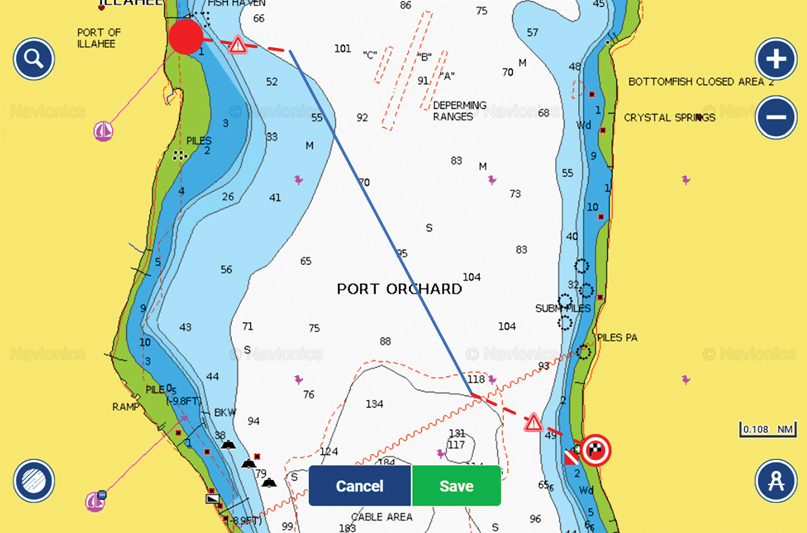Auto-routing software for boats first appeared over five years ago when Garmin took their road-based navigation to the water. Since then there have been a myriad of updates, technological advances, and new players in the marketplace. The basic idea is that you can enter a start and finish coordinate on an electronic chart and the algorithms in the software will determine the safest route based on the description of your boat and the navigational aids on the chart.
Garmin refers to it as “auto guidance” while Navionics (owned by Garmin), Raymarine, and Navico (Lowrance, Simrad, and B&G) refer to it as dock-to-dock auto-routing. To start, you enter your boat’s safe depth, width, and height parameters. Once you enter your starting point and your destination, the software will plot waypoints (a route) for you to follow. It can also provide the total distance, time to your destination, and fuel consumption.
The first time I used the software, I entered the actual draft of my boat, which was a mistake. I should have used the depth of water that I felt comfortable with! My boat draws 6’ but I would prefer to be in 10’ of water. In the initial setup, you can either enter 10’ or enter 6’ with a keel offset of 4’. The challenge, in shallow water, is to remember if you set the keel offset or not. And remember, the depth calculation is based on a zero tide.
One of the best applications of auto-routing is trip planning. I commonly find myself wondering where I should go next. Ultimately, part of that decision is the distance to the next destination. Using the auto-route feature, I quickly calculate the distance to various destinations around me. Having those realistic routing distances readily available allows me to decide how far I’ll go on my next destination.
Quite often the system will plot the shortest route possible, however, many areas in the Pacific Northwest contain traffic separation zones and shipping lanes. These will show up as warning triangles along the route. In these cases, you can tap anywhere along the navigation route and drag the waypoint to where you want it to clear an obstacle. When you release the new waypoint, the software will automatically re-calculate the route and update your distance and time to destination.

While you are underway, you can watch your progress and see the updated stats. Another cool feature is that you can browse through services and points of interest like marinas, restaurants, or marine repair shops. Using Navionics or the Garmin Active Captain App, you can call directly from the app to either a VHF channel or a telephone number to confirm a slip assignment or make reservations. You can even get fuel prices and write reviews. If you have a compatible chartplotter you may be able to transfer auto-routing information and software updates from your smart device.
If you are using a mobile app, it relies on the internal GPS receiver of your device to determine location. If your device does not have an internal GPS, you can automatically pair it with your compatible chartplotter via Bluetooth, and the chartplotter will give you the GPS information. GPS Exchange Format (GPX) is more or less the standard data format that the marine electronics industry uses, which allows you to share files with friends and other chartplotters. You can still use an SD card and the apps will automatically share routes, waypoints, track logs, software updates, screenshots, and sonar recordings.
When choosing a navigation system, it is important to understand the difference between raster and vector charts. Most multifunction displays have charts available in either format, but apps usually use only one. A raster chart is basically a photocopy of a paper chart and require significantly more digital storage. However, if you are familiar with paper charts, there is little-to-no learning curve. Vector charts are a digital copy of a raster chart and allow you to access additional information as you zoom in. That is how you can view details about marinas and even access social media.
The bottom line is that auto-routing is a very cool feature, but it is based on electronic chart information and is not a replacement for safe, visual navigation practices. Give it a try!


